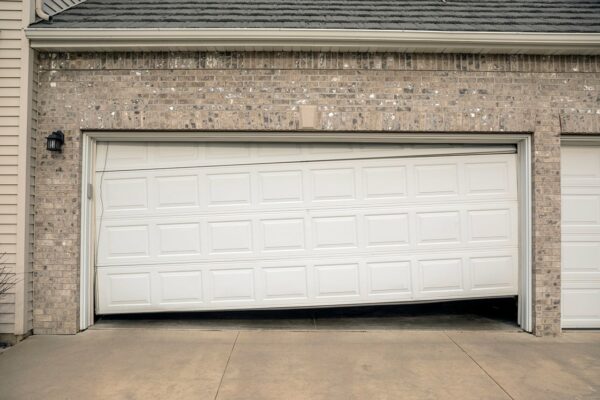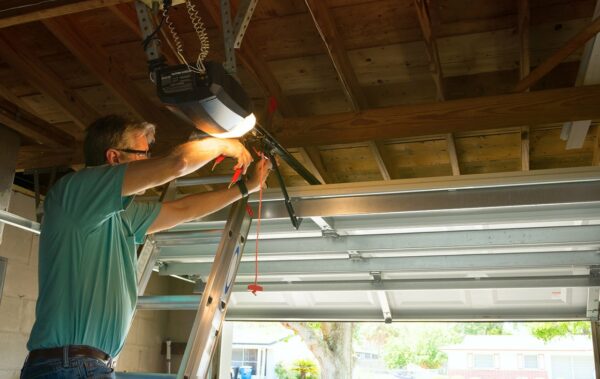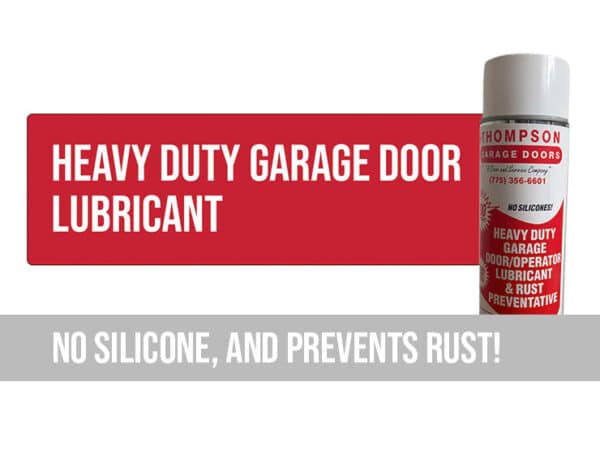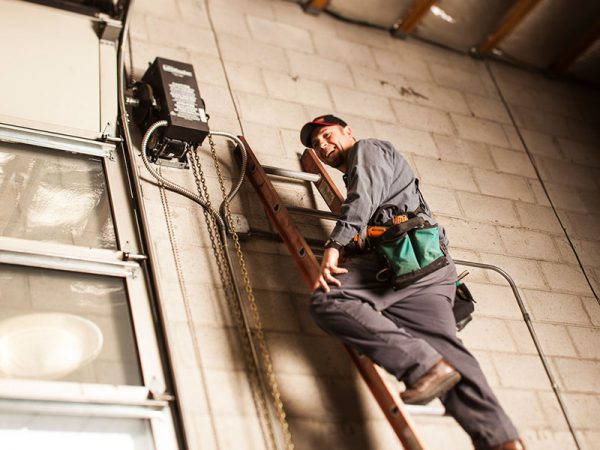You come home one after picking up your kids from school, only to find that your garage door won’t open or won’t close. That means the inevitable has happened – your garage door is broken.
That’s when you start wondering how to fix a broken garage door.
Garage doors are heavy pieces of equipment with lots of moving parts. In other words, it’s not easy to fix a broken garage door on your own. It takes training and necessary tools, including safety gear, to do the job yourself.
If you’re having issues with your garage door opening, loose hardware, a broken spring, or any other issue, it’s highly recommended to call in an expert instead of attempting a DIY fix. This way, you can ensure the repair is done correctly and safely, and it extends the life of your garage door.
Here are six common garage door problems – and the remedies.
1. Repairing A Broken Garage Door Spring
Generally, a new garage door isn’t necessary when a spring gets damaged. It’s one of the most common garage door problems. A technician will be able to fix it without doing a complete replacement.
Garage door springs help lift the heavy door, which means they’re constantly under tremendous tension. The springs apply a twisting force to the torsion tube while the drums at the ends of the tube act as reels, winding up the cables as the garage door opens.
That’s why spring replacement is a task you should leave to the experts. It can be dangerous for a novice DIY enthusiast.
Plus, it can damage your door if you attempt to do it without the proper tools and training.
Garage door springs come in different sizes and lengths.
First, your technician will help you find garage door spring replacement options that match the existing lengths and diameters. Next, your garage door repair expert will remove the damaged springs and replace them with new ones.
Depending on the kind of springs installed (standard torsion springs vs. double life torsion springs), you can get 7,000 to 25,000 open/close cycles out of them. In other words, you won’t have to look for “garage door stores near me” anytime soon again. That’s one more benefit of hiring a professional.
2. Repairing a Broken Cable
The cable is another crucial part of a garage door. They are attached to the bottom of the door, as well as to the drums. The torsion spring will turn the drums, causing the cables to unwrap from them as the door closes or wrap around them as it opens.
In short, they are a key component in raising and lowering a commercial or a home garage door.
When a cable breaks, your garage door won’t lift evenly. Continuing to operate it in this state puts stress on other parts of the system (the metal tracks, the rollers, and the other cable), leading to more extensive damage. So, get the cables replaced right away.
As you can imagine, this isn’t one of the DIY garage door repair solutions.
You will need to call professional garage door services to replace the cables. They’ll start by opening the door and using vice grips or another object to prevent it from closing down during the replacement process. The technician will remove the old cable and install the new one. It also includes affixing the cable into place at both ends.
3. Repairing Bent or Broken Garage Door Tracks

You can avoid costly garage door repairs by simply keeping an eye on your door. Here are a few signs you’ve got to watch out for:
- The door is shaky or uneven when it opens or closes
- The door rails have dents, chips, or other issues
If you see these signs, call your local garage door repair company. They will determine if the door track is bent, broken, or otherwise needs repair to avoid more problems down the road.
The track is what the unit moves along as the door opens and closes. It’s a critical piece of equipment in your garage door.
When you contact someone from one of your garage door solution and repair services, they’ll spend some time inspecting the track. If they notice a damaged portion, they may be able to loosen the bolts and move it back into place. They may also add lubrication to the tracks and wheels to keep it running smoothly.
4. Repairing Damaged Sections

There are many ways a section of your garage door can suffer damage. For example, parts of your garage door could end up dented if you accidentally backed your car into it or if there was hail or strong winds in your area. On the other hand, steel garage doors can gather rust over time, damaging one or more panels. When that happens, you will need to replace your garage door panels.
But like most other garage door repair solutions, this one also needs an expert. Trying to do this the DIY way can be dangerous, especially with proper training and safety gear. Garage doors are heavy and under a lot of tension. Unlike a DIY enthusiast, a trained service technician knows the safety risks and has the training needed to fix your broken garage door. They can replace a panel relatively quickly and easily.
Generally, your technician will start by raising the door, undoing the springs, and lowering it most of the way. From here, they will loosen the bolts that hold the panel in place, affix the new panel, and secure the bolts.
However, you may not get a matching panel or one that fits correctly for older doors. Finding a perfect match depends on the type of garage door you have and its age. In such cases, new garage door installation may be necessary.
5. Troubleshooting Electronic and Opener Failure

Sometimes, your garage door opener simply refuses to work. This could mean a lot of things. It could be your opener, keypad, wall switch, or remote. Only a trained professional can help you with the right garage door repair solution. So, make a service call as soon as your garage door opener stops working.
The cause may be as simple as dead batteries or an unplugged garage door motor. Or, a fuse could have tripped or burned out, the motor may need replacement, or the keypad could need reprogramming.
In this case, a new garage door opener will rarely be required. However, as there are many possible underlying causes, contacting a service technician is usually best. They will know how to fix your broken garage door opener.
Don’t wait, repair your garage door today!

6. Dealing with Dried-Up Grease
Dried-up grease is the root of some common garage door problems. It can build up over time with regular use, eventually causing issues with your garage door. Generally, professional garage door repair services can help if you’re facing this issue.
It depends on the type of garage door you have and its condition, but a technician might decide to clean the dried-up grease out of the tracks. Then, they can apply lubricant to ensure that the wheels and tracks run smoothly once again. They can also perform a tune-up to make sure all other elements of your door are in tip-top shape.
Contact Your Local Garage Door Solution and Repair Service Now
Hopefully, this piece has helped you understand common garage door issues – and how to fix them. In most cases, the best solution is to contact your local experts. They will know how to fix your broken garage door, whether it’s the damaged panel, spring, cable, or tracks. So, when your garage door stops working, call in the experts as soon as possible.
At Thompson Garage Doors, we’ve been taking care of these needs for homeowners in northern Nevada and northern California since 1957.
If you need to repair a garage door, we’ve got you covered. Our technicians provide on-time, excellent service you can trust, as well as emergency and same-day service. Call 775.356.6601 or fill out the online form for questions about your door, installation services, or to hire a technician.
